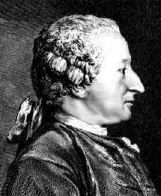

Alexis Clairaut was educated at home by his father, who taught mathematics in Paris. He learned to read from Euclid's Elements, and by the age
of 9 he had mastered the a textbook on calculus and analytical geometry. In the following year, Clairaut went on to study de L'Hôpital's books.
He read his first paper to the Paris Academy at the tender age of 13. He began to undertake research on double curvature curves which he completed in 1729. As a result of this work he became the youngest person ever elected to the Paris Academy in 1731. There he joined a small group who supported the natural philosophy of Newton.
Clairaut became close friends of Voltaire, Maupertuis, and du Châtelet, and he ended up doing important work with the latter two.
Clairaut also became friends with König and, for many years, the two continued a useful scientific collaboration by correspondence.
Clairaut published some important work during the period 1733 to 1743. He wrote a paper in 1733 on the calculus of variations, and in the same year he published on the geodesics of quadrics of rotation. The following year Clairaut studied the differential equations now known as Clairaut's differential equations, and gave a singular solution in addition to the general integral of the equations. In 1739 and 1740, he published further work on the
integral calculus, proving the existence of integrating factors for solving first order differential equations (a topic which also interested Johann Bernoulli,
Reyneau and Euler). In 1742, Clairaut published an important work on dynamics.
In 1743, Clairaut published a book confirming the Newton-Huygens belief that the Earth was flattened at the poles. The book was a theoretical study to support the experimental data on the shape of the Earth which an expedition had gathered. The book was an important
one in laying the foundations for the study of hydrostatics. It built on foundations due to Newton and Huygens who had put forward the theory that the
Earth was an oblate spheroid, and also on Maclaurin's work on tides which developed some background results in hydrostatics.
After this work, Clairaut began to work on the three-body problem in 1745, in particular on the problem of the moon's orbit. He came to the conclusion that Newton's theory of gravity was incorrect, and that the inverse square law did not hold. He spent several years trying to convince the scientific world of this, and he published on the subject in 1752.
Clairaut decided to apply his knowledge of the three-body problem to compute the orbit of Halley's comet and predict the exact date of its return. This
required much more accurate approximations than had the problem of the moon. When the comet appeared only one month before the predicted date, Clairaut was given
great public acclaim. There was a suggestion that the comet be renamed after Clairaut, and Clairaut was called the "new Thales".
Clairaut also made important contributions to the aberration of light. He was particularly interested in the ideas of improving telescope design by using lenses made up of two different
types of glass. Clairaut wrote some important memoirs on the topic, studying the theory as well as conducting optical experiments. This work was still incomplete at the time of his death.
Clairaut worked on a wide range of problems within mathematics. A book on algebra was published in 1749, in which he took the subject up to the solution of equations of degree four. He tried, with great success, to show why the introduction of algebraic notation was necessary and inevitable. The book was used for teaching in French schools for many years. He also published a geometry book in the year of his death.
He was elected to the Royal Society of London and the Academies of Berlin, St Petersburg, Bologna and Uppsala.